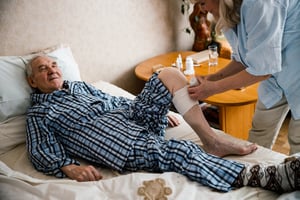Surgical Site Infection (SSI) imposes a substantial financial burden on European healthcare...
Interview Task_Blog Could Isla be the key to reducing NHS waiting lists?
The NHS is dealing, with a perfect storm of serious challenges; the ramifications of austerity and reductions to social support, population growth as well as the struggles of recruiting and retaining staff post-Brexit, all of which are exacerbated by the extreme pressures put on the service during and since the pandemic.This combination of factors (and many more) have resulted in a myriad of issues, including some of the worst waiting lists since the NHS’ inception over 70 years ago. These new problems require new solutions and it possible that digital innovation may be a key piece in finding a solution.
The scale of the problem
Currently, a significant peak has been reached, highlighting the struggle of 7 million individuals on waiting lists.. And out of them, almost 400,000 have been waiting for a really long time, like a whole year!

What’s the plan to resolve this?
NHS England have set out targets to carry out 30% more treatments by 2024, but this goal appears an ambitious one given the scale of the problem. This huge problem requires a multi-faceted solution involving planning, resource management as well as the strategic intervention of digital tools.
How can remote care help?
The NHS have already started plans to increase the introduction of virtual wards and other remote monitoring pathways, allowing more patients to be diagnosed,
treated and cared for outside of clinical settings where appropriate.
Isla’s software allows remote monitoring to be delivered at scale by allowing patients to submit photos, videos, digital PROMs and sound recordings while they safely recover at home. Pathways can be automated according to schedules, producing a continuous flow of data which allows clinicians to take a user-centred approach, ensuring the appointments are efficient and waiting lists appropriately prioritised.
Reducing unnecessary follow-up appointments
- Isla has helped Trusts reduce the number of in-person appointments where not clinically necessary.
- A single London Trust was able to reduce their follow-ups by 342 in one year in just one pathway
- 15% of follow-ups avoided in the Burns dressing clinic
Efficient consultations:
- Through automated schedules, Isla has helped clinicians obtain standardised and structured patient information in advance of in-person or virtual consultations. This ensures that appointments are focused on clinical time, rather than admin time.
- Acne pathway saved 10-15 minutes per patient per consultation.
- Vulval clinic saved 6 minutes per patient per consultation.
- In two-week-wait Telederm, 75% of patients completed their assessment form in advance of a Medical Photography appointment, resulting in a reduction of 50% of clinical time.
A reduction in costly, avoidable incidents
- Often, an image presented in real time to the relevant clinical teams can ensure that certain costly incidents, for both the patient and the hospital, are avoided. This saves money, but also releases capacity to treat other patients
- In C-section, Isla helped the clinicians reduce Surgical Site Infection (SSI) incidents from a monthly average of 15 to 5
- Isla’s introduction into Cardiac Surgery supported the team in avoiding 3 readmissions in Q2 of this year – which on average cost the hospital £10k each
If you are interested in discussing how Isla may be able to assist your organisation or serice please email us at or visit our website at www.isla. for more information.
If you’re interested in seeing how Isla can support your clinical pathways contact us here.
.png?width=170&height=76&name=isla-logo-full%20(2).png)
.jpg?width=2121&height=1414&name=iStock-1387432270%20(1).jpg)

